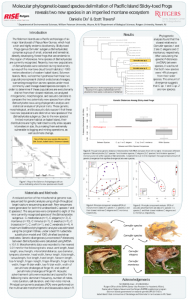Dix, Danielle: Molecular Phylogenetic-Based Species Delimitation Of Pacific Island Sticky-Toed Frogs Reveals Two New Species In An Imperiled Montane Ecosystem
Title: Molecular Phylogenetic-Based Species Delimitation Of Pacific Island Sticky-Toed Frogs Reveals Two New Species In An Imperiled Montane Ecosystem
Name: Danielle Dix
Home Institute: William Paterson University
Programs: RISE program, INSPIRE Postdoctoral Research and Education Program
Other contributors: Scott Travers
Abstract: The Solomon Islands are a Pacific archipelago of six major Islands east of Papua New Guinea, which host a rich and highly endemic biodiversity. Sticky-toed Frogs (genus Cornufer: subgenus Batrachylodes) comprise a group of small, arboreal and terrestrial, directly-developing, forest frogs that are endemic to this region of Melanesia. Nine species of Batrachylodes are currently recognized. Recently, two new populations of Batrachylodes were collected during biodiversity surveys of the montane cloud forest habitats (>1000 meters elevation) of eastern Isabel Island, Solomon Islands. Here, we test the hypothesis that these two populations represent distinct evolutionary lineages, warranting recognition as new species under most commonly used lineage-based species concepts. In order to determine if these populations are evolutionarily distinct from their closest relatives, we analyzed mitogenomic, morphological, and acoustic call data to compare the two potentially new species from other Batrachylodes taxa using phylogenetic analysis and statistical analysis of physical traits. These genetic, morphological, and bioacoustic data support that these two new populations are distinctive new species of the Batrachylodes subgenus. Due to the new species’ limited montane habitat on Isabel Island, their distributions are highly restricted to only a few square kilometers in size, thus making them extremely vulnerable to logging and mining operations, as well as climate change.
Biography: Danielle Dix is a rising junior at William Paterson University. She is an environmental science major and has been on the Dean’s list for the college of science and health for two years. After graduation, she hopes to help with conservation efforts and make a difference.
